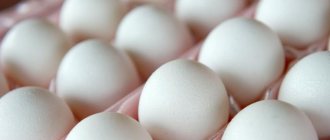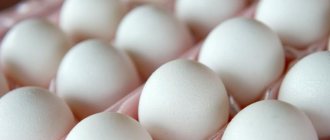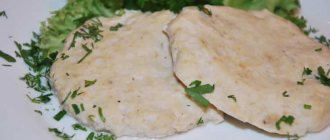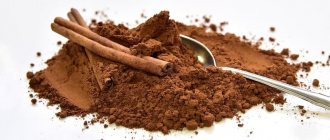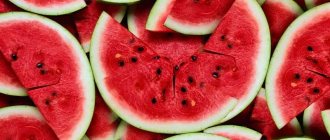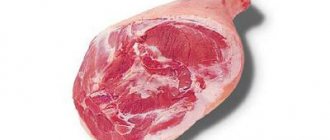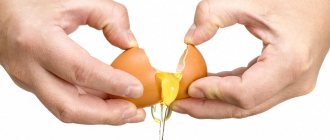How many proteins are in 1 egg (white + yolk)
A significant part of the composition of the egg is made up of proteins - about 13 g per 100 g of product. In 1 piece first category, weighing 50 g - about 6.5 g. The amount of this nutrient in the protein and yolk is different. The yolk contains fewer amino acids, it has more calories, and the protein content does not exceed 16%. The main protein components in the yolk are phosphovitin, livetin, and vitellin.
When cooked, the product does not lose its beneficial properties. Protein content in a boiled egg: 1 pc. – 6 g, in 100 g – 12 g.
The protein contains a protein called ovalbumin (~ 68% of the protein composition), which has antibacterial and restorative properties, the rest is avidin, conalbumin, ovomucin and ovoglobulin. Thanks to a large number of useful amino acids, the product is perfectly absorbed by the body. The protein content of egg whites is 13%, the largest part being water – about 80%.
Number of calories in protein and yolk
Most of the calories in a boiled egg are contained in the yolk. Its calorie content is 55 g due to proteins and fats. At the same time, egg whites are packed with nutrients without the fat. Eating one large egg white (grade 1 egg) provides 4-5 grams of protein and only 17 calories with virtually no fat. Proteins are also a good source of leucine, an amino acid that can help with weight loss.
Most hard-boiled egg nutritional information available online is based on a 1-egg serving of the first category.
When eating selected eggs, you need to recalculate these indicators upward. Select eggs are easy to find in stores and are often more wallet-friendly. Eggs of the 2nd and 3rd categories, of course, contain fewer calories and less fat.
Fats in 1 egg, raw and boiled
Most of the calorie content of the product (160 kcal) comes from the yolks - more than 70%. The total fat content of a raw egg is 11%; when boiled, this figure remains virtually unchanged. One piece weighing 50 g contains 5.5 g of fat.
Yolks contain 30 g of fat (per 100 g), while whites have zero fat.
The yolk contains many unsaturated fatty acids. Some of them are linoleic, oleic, and stearic, representing, respectively, the groups of polyunsaturated, monounsaturated and saturated acids. Due to the cholesterol it contains, daily consumption of the product should be limited to 3 pieces.
Fats and cholesterol in eggs
Some healthy eaters are wary of the cholesterol found in eggs, but dietary cholesterol and that found in the blood (which is tested to determine the risk of heart disease) are two completely different things.
According to modern medicine, eating foods high in cholesterol does not have a significant effect on the risk of heart disease. Instead, experts recommend reducing your intake of saturated and trans fats to keep your blood cholesterol levels at healthy levels.
While eggs contain saturated fat, they also contain some polyunsaturated and slightly higher amounts of monounsaturated fat. They are considered "good" fats because they have been shown to help lower LDL (low-density lipoprotein), or "bad" cholesterol, and promote heart health. For this reason, nutritionists recommend choosing foods containing both poly- and monounsaturated fats over those containing saturated fats.
Carbohydrates in eggs
Fans of a healthy lifestyle and those losing weight should not worry about eating chicken eggs, because their carbohydrate content is less than 1 g. More precisely, 0.7 g. A product of the highest and first category, whose weight reaches 80 g, includes about 0.5 g.
A low category and small sized egg will contain between 0.2g and 0.4g of carbohydrates.
The indicator for the yolk (per 100 g of weight) is 1 g, for the white - 0.65 g. Carbohydrates in the product are represented only by sugars. When cooked, the indicator remains virtually unchanged - 0.8 g per 100 g.
Chemical composition of egg yolk
On average, the yolk accounts for 33% of the total egg volume. It contains 100% fat-soluble vitamins, carotenoids and 90% microelements.
Chemical composition:
| Name | norm, mg per day | chicken, mg | quail, mg | goose, mg | ostrich, mg |
| water | 2273 g | 74.1 g | 73 g | 70.83 g | 51.6 g |
| ash | — | 1 g | 1.2 g | 1.14 g | 0.9 g |
| beta carotene | 5 | 0,06 | 0,08 | 0,013 | 36,6 |
| vitamin A | 900 mcg | 250 mcg | 483 mcg | 187 mcg | 195 mcg |
| vitamin E | 15 | 2 | 0,9 | 1,34 | 1,05 |
| phosphorus | 800 | 192 | 218 | 208 | 198 |
| sodium | 1300 | 140 | 115 | 138 | 142 |
| calcium | 1000 | 55 | 54 | 60 | 56 |
| choline | 500 | 251 | 507 | 263,4 | 293,8 |
We recommend that you familiarize yourself with the BZHU of kvass
Eggs are an excellent preventative against premature aging. Vitamin D and all B vitamins help reduce the manifestations of aging of the body. It also contains iodine, sulfur, potassium, essential amino acids, and polyunsaturated amino acids.
Egg composition and nutritional value
The eggs of different bird species differ in composition, the ratio of nutrients and their own weight. The weight of chicken ranges from 40 to 80 g, so for convenience it is customary to supply the amount of nutrients for them, as for all products, per 100 g of raw material. That is, data on the nutritional value of eggs is the average statistical value not for 1 piece, but for 100 g, which must be taken into account when preparing a diet.
The nutritional uniqueness of eggs is explained by their composition; in all birds they consist of:
- shells,
- squirrel;
- yolk.
The shell takes up from 10 to 13% of the total weight and has no energy value for humans. It is used after special processing as a food additive as a source of easily digestible calcium.
The clear liquid part of the egg is the white, which contains water, nutrients, vitamins and minerals.
Protein composition
| Element | Percentage |
| water | 85% |
| proteins | 13% |
| fats | 0,3% |
| carbohydrates | 0,7% |
| mineral salts, glucose, enzymes, vitamins | 1% |
| energy value | 44 kcal per 100 g |
The yolk makes up about a third of the total mass and consists mainly of fatty acids. The average egg contains 6 to 7 grams of fat. The yolk mass consists of substances beneficial to humans.
Chemical composition of yolk
| Element | Benefits for humans |
| water | for water-salt metabolism |
| fatty acids: linoleic, linolenic, oleic, palmitic, stearic | for lipid metabolism |
| trace elements - calcium, potassium, iron, phosphorus, magnesium, zinc, iodine, selenium | for strong bones and strong muscles, high hemoglobin, thyroid hormones |
| fat-soluble vitamins - E and D | have a beneficial effect on the condition of hair, nails and skin; |
| B vitamins - B1, B3, B6, B12 | for a strong nervous system and healthy musculoskeletal system |
| vitamin A | for good vision |
| biotin | to regulate metabolism |
| folic acid | for cell growth and development |
| choline | for fat metabolism |
| lecithin | essential element of cell membranes |
| cholesterol | for the synthesis of steroid hormones, vitamin D and bile acid, strengthening cell membranes |
| energy value | 352 kcal per 100 g |
Cholesterol is contained only in yolks (up to 570 mg) and is the least harmful to humans, since its effect is neutralized by lecithin.
There are very few carbohydrates in an egg, approximately 1g, and their main location is the yolk. Of the total mass of the yolk, carbohydrates occupy 3.6%; these are mono- and polysaccharides, and dietary fiber and fiber are absent.
The amount of nutrients depends on the cooking method. The ratio of protein, fat and carbohydrates of a cooked product differs from that of a raw or fried product due to the heat treatment, which destroys the proteins, as well as the addition of oil during frying. There is the same amount of fat in a boiled egg as in a raw one, but less than in a fried one.
Chicken egg calorie content
Eggs are eaten raw and heat-treated. The nutritional and energy value of this product depends on the method of its preparation and weight.
Cooks and nutritionists offer various recipes for cooking eggs:
- boiled - hard-boiled, in a bag, soft-boiled;
- fried - fried eggs, scrambled eggs;
- omelette - whipped with milk or kefir, with the addition of flour;
- shakshuka - vegetables and eggs cooked in a frying pan;
- “in a bag” or poached is cooked in a special way without shells in water.
The calorie content of eggs increases if you use butter, sauces, cheese and other ingredients when cooking. During the period of weight loss, you should limit yourself to only boiled product.
You can find out the weight of your testicles without a kitchen scale. Depending on the weight and size, all poultry farms are required to label them according to certain standards. The marking consists of two characters:
- The first is the letters “D” or “S”. D - means dietary, stored for no more than 7 days from the moment it was laid by the chicken. C - table, stored for 25 days.
- The second sign - numbers 1, 2, 3 or the letters “O” and “B” indicate the weight of the egg:
- 1 - weight from 55 to 64.9 g;
- 2 - from 45 to 54.9 g;
- 3 - from 35 to 44.9 g;
- O - from 65 to 74.9 g;
- B - from 75 and above.
The calorie content of one egg can be calculated accurately if you know its weight without the shell by weighing it on a kitchen scale. On average, a chicken egg weighs 50-60 g. A raw chicken egg per 100 g of product contains 158 kcal, the calorie content of a hard-boiled chicken egg per 100 g is 155 kcal, a soft-boiled egg is 78 kcal.
In a raw egg
In order to control the ratio of nutrients, it is more convenient to use information about how much protein and fat is in 1 piece of raw or boiled egg. It's easy to calculate:
- 100 grams of raw egg contains 158 kcal;
- the average weight of a C1 egg is 60 g;
- multiply 60 by 158 and divide by 100, 60*158:100=94.8 kcal.
Boiled
Boiled chicken egg is a unique product for children's, dietary, healthy or sports nutrition. Nutritionists in most cases recommend consuming boiled ones, since this method of preparation preserves most of the nutrients and energy value of the product, and the risk of salmonella infection is reduced.
In boiled eggs, the protein is in the most convenient state for absorption by the human body and can satisfy hunger for several hours. The calorie content of a boiled egg is slightly inferior to a raw one and depends on the cooking time, the state of the white and yolk.
Before boiling eggs, you should check their freshness and wash the shells under running warm water. Boiling methods:
- soft-boiled egg - with a liquid yolk and tender white, for this it is kept in boiling water for 2 minutes;
- “in a bag” or poached - 4 minutes;
- hard-boiled egg - need to cook for 7 minutes.
The longer they sit in boiling water, the harder the yolk will be. If boiled for too long, the yolk may change color, turn green and lose most of its nutrients.
The number of calories in a boiled egg is determined by the proteins of the white and the fats of the yolk; the calorie content per 100 grams will depend on the degree of boiling - the less heat treatment, the higher the energy value. The yolk contains more calories, the calorie content of 1 piece is about 40 kcal.
| Energy value of boiled chicken egg | |
| per 100 g of product | 155 kcal |
| in a soft-boiled egg | 70 kcal |
| hard-boiled | 55-60 kcal |
Fried
A fried egg has more calories than a raw or boiled egg, depending on the cooking method:
| Method for preparing chicken eggs | Calorie content |
| fried in a pan without fat | 100 kcal |
| fried in oil | 125 kcal |
| 2 egg scrambled eggs | 250 kcal |
| 2 egg omelette | 300 kcal |
| egg white omelette | 128 kcal per 100 g of product |
Please note: an egg fried in a non-stick pan contains almost as many calories as two boiled eggs.
In egg powder
In the food industry, egg powder is used for preparing products, 1 kilogram of which corresponds to 90 pieces of a natural product. 100 g of egg powder contains 542 kcal.
In one white and yolk
In sports and dietary nutrition, it is common to use protein and yolk separately to regulate nutrient levels. Chicken yolk has more calories than protein; it saturates the body with vitamins, minerals and healthy fats. Egg yolk gets a high calorie content due to the content of fatty acids, therefore, with a relatively low weight compared to protein, its energy value predominates. Eating only proteins increases the amount of proteins, which is necessary when cutting the body or gaining muscle mass.
The calorie content of an egg without yolk (white only) is 20 kcal, in the yolk 50 kcal. Boiled yolk practically does not lose its calorie content.
Dietary eggs marked “D” on the shell differ from others in their freshness and shelf life - no more than 7 days, after which they become table eggs. Their nutritional value is higher due to the activity of enzymes, the energy value is standard, like the rest.
How many eggs can you eat?
The rate of egg consumption depends on the following factors:
- age;
- individual tolerance;
- physical activity;
- health status.
Children begin to introduce yolk into their diet with their first complementary foods at the age of 7 months. Protein is offered later due to a possible allergic reaction. At 2-3 years old, children can be given up to 3 yolks per week.
If you have normal cholesterol levels and no allergies, you can consume 2 pieces per day. This amount will enrich the diet with proteins, vitamins and healthy fats. If cholesterol levels are high, limit consumption to 3 pieces per week.
During a weight loss diet, it is often recommended to eat only whites and keep the yolk to a minimum. During active physical training, athletes can increase the number of eggs to ten per day.
The permissible norm of raw chicken eggs is 1 piece per day. This is due to the threat of salmonellosis, a dangerous intestinal infection caused by the Salmonella bacterium. To avoid illness, it is recommended to use only fresh eggs, without traces of contamination, and wash them with hot water before use. There is also a possibility of hypovitaminosis of vitamin H (biotin) due to the high content of avedin, a protein that binds biotin and converts it into an inactive form.
Eggs in dietary nutrition
- Eggs can safely be called a dietary product. Firstly, one egg contains as much as 5-6 g of protein, despite its rather low calorie content.
- Eggs satiate well even in small volumes, thus eliminating small snacks between meals.
- Compared to the bulk of dietary products, eggs have another advantage - low cost.
In addition, eggs are a source of not only proteins, but also fats. This is important because lipids saturate the body no worse than proteins, and a feeling of satiety will help you reduce food portions and lose excess weight faster. Under no circumstances should you give up fat completely, even on a diet: the body needs a balanced diet in order to function normally.
When following a low-calorie diet, it is necessary to separate the whites from the yolks and the number of calories in the same omelet will be significantly reduced.
Some strive so hard to lose weight that they develop many health problems through fasting and mono-diets. After such a blow to the body, it needs recovery, one that will not return the weight to its previous figures. Eggs are perfect for this.
How many calories are in other types of eggs?
Nutritionists and nutritionists recommend consuming eggs and other birds (not just domestic chickens) to diversify your diet.
In quail
The healthiest eggs are in terms of vitamin content, which are contained 2-2.5 times more than chicken eggs. Eating quail eggs is recommended for people with diseases of the digestive system and allergies to chicken egg white. It is also useful to include quail eggs in the diet of babies to prevent rickets and vitamin D deficiency. Energy value is 168 kcal per 100 grams.
Ostrich
For Russian consumers, ostrich eggs are an exotic product that can be tasted on ostrich farms. One such egg is 40 times larger than a chicken egg, but the calorie content of an ostrich egg is lower than that of poultry. A raw egg contains 118 kilocalories per 100 g. The dietary properties of ostrich eggs are explained by their lower content of fatty acids and cholesterol.
Gusin
Goose eggs are a high-calorie product, the raw energy value per 100 g of product is 185 kcal. They are 4 times larger in size than chicken ones, the number of calories in 1 piece is 370 kcal. They contain lutein, a substance that can slow down the aging process of body cells.
Indyushin
Turkey eggs are closest to chicken eggs in composition; the ratio of protein, fat and carbohydrates of boiled eggs of these poultry is almost the same. They are slightly larger in size than chicken eggs and weigh about 75 g. Energy value is 165 kcal per 100 g, one egg contains 124 kcal.
Bird eggs are a common food product. When properly selected, stored and prepared, they help maintain health and fitness. A wide variety of recipes will delight gourmets, and detailed data on nutritional and energy values will help those who are on a diet and losing weight.
Fried
You can prepare the product in different ways - omelet or scrambled eggs are tasty, healthy, and great for breakfast or dinner. Let's talk in more detail about how many carbohydrates are in 1 egg! All calculations are given in grams.
Fried without oil – 0.7. And also:
- Proteins – 14.6;
- Fats – 13.
We also recommend: Lack of magnesium in the body: symptoms in women
Fried in vegetable oil – 0.7. Besides:
- Proteins – 11;
- Fats – 12.
Fried in butter – 0.7. And:
- Proteins – 10;
- Fats – 26.
The benefits and harms of boiled eggs for weight loss
A chicken egg contains a large amount of useful substances. The protein that the product contains is the most digestible and contains a large number of useful elements.
The substances that egg whites contain help restore immunity after various diseases, and are also required for the development process, especially for children.
The yolk contains microelements such as:
- Vitamins of groups A, B, E
- Calcium
- Iron
- Phosphorus
- Kholin
- Lecithin
For those who want to lose extra pounds, consuming this product can reduce calories consumed and satisfy the feeling of hunger.
Nutritionists recommend consuming boiled eggs during the weight loss procedure to saturate the body with useful substances, and consuming the product for breakfast allows you to get the necessary energy, while the number of calories consumed remains low.
However, in addition to beneficial properties, the product has some harmful ones. It should be noted that the consumption of the product should be reduced to the following categories of people:
- If you have protein intolerance
- For allergic reactions to yolk
- People who have high cholesterol levels
- Presence of diabetes mellitus
- Previous heart attacks and strokes.
Let's celebrate! It is also necessary to take into account the fact that consuming large quantities of the product also has a negative impact on a person’s well-being, especially when following a diet. People suffering from obesity should be very careful when consuming egg yolks, as constipation may worsen.
Daily consumption rate
In order for the product to be beneficial, experts recommend eating no more than 4 pieces per day. If this indicator is exceeded, a person is at risk of increasing cholesterol levels.
For those who want to lose weight, the permissible norm per day is no more than 2 pieces. For people suffering from diabetes mellitus, the permissible norm of the product is no more than one per week.
Note! Dietary nutrition experts note that it is advisable to consume the product in hard-boiled or soft-boiled form. Eating raw food of this type is practically not absorbed by the body and can lead to the presence of a dangerous stomach disease.
